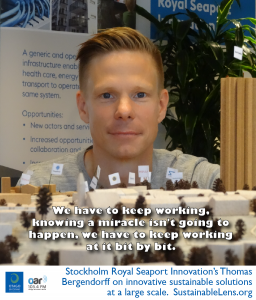The first step is getting the people in the room, and then you have to get something done
Thomas Bergendorff is coordinator at Stockholm Royal Seaport Innovation. Thomas is goal is finding innovative sustainable solutions on a large scale. He does this by bringing together companies, academics and the City of Stockholm, working across sectoral boundaries to work towards delivering upon ambitious environmental and sustainability targets for a large scale sustainable urban development.
Talking points
The first step is getting the people in the room, and then you have to get something done
We have to change the world
We have to do something, we can’t just point finger and hope that someone else will fix it for us
I have got the best job in the world.
We have to keep working, knowing a miracle isn’t going to happen, we have to keep working at it bit by bit.
Transformation depends on what timescale you are looking at, incremental change looked at over a longer time scale – we can look back and realise that was a transformation.
Short term thinking is part of the problem, that’s what got us here. Thinking like little kids.
We need a transformational change, that’s a lot of incremental changes to get us there. But it’s not all linear, those incremental changes are getting us to the window of opportunity – an institutional, political, financial, right-people-at-the-right-time window. You do incremental change until you get to the window of opportunity, and then you go with a big, real transformation.
(Activist) Not really, a facilitator that enables other people to be activists, much as I would like to be an activist, because it’s much more romantic to be an activist. I’m doing the necessary work so that other people will be the activists.
I’m a generalist with a wide ranging programme. But how do I prioritse, am I doing the right thing today?
How do we do as much as possible? What are the optimal processes and tools?
My goal has to be to get as many things off the ground as possible. We need tools and processes to do that.
Don’t worry too much, just follow your heart and work hard.


